The name of this pub recalls the Central Congregational Chapel built on this site in c1901. By 1914, there were 60 such non-conformist chapels in Cardiff. These were chapels for those outside of the Church of England, dating from the 16th century. The Congregational Union was formed in 1832. The English Presbyterian Church was built in Windsor Place, in the 1860s, just a few doors from this Wetherspoon pub, and is now the United Reformed Church.
An illustration and text about the history of the area formerly known as Crockherbtown.
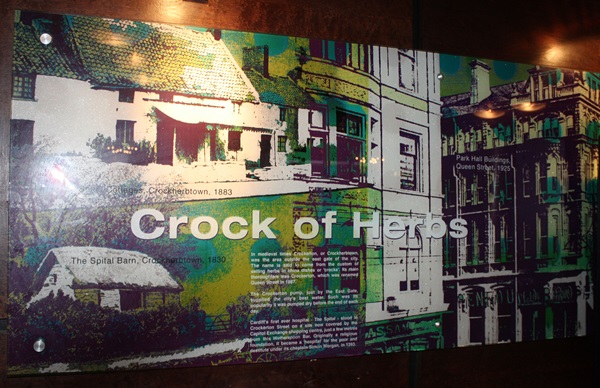
The text reads: In medieval times Crockerton, or Crockherbtown was the area outside the east gate of the city. The name is said to come from the custom of selling herbs in china dishes or ‘crocks’. Its main thoeoughfare was Crockerton, which was renamed Queen street in 1887.
The crockerton pump, just by the East Gate, supplied the city’s best. Such was its popularity it was pumped dry before the end of each day.
Cardiff’s first ever hospital – The Spital – stood in Crockerton Street on a site noe covered by the Capitol Exchange shopping centre, just a few metres from this Wetherspoon Bar. Originally a religious foundation, it became a ‘hospital’ for the poor and destitute under its chaplain Simon Worgan, in 1393.
The photos include: Spital Cottages, Crockerbtown, 1883;
The Spital Barn, Crockherbtown, 1830;
Park Hall Buildings, Queen Street, 1925.
An illustration and text about the history of the area of Cardiff known as Grey Friars.
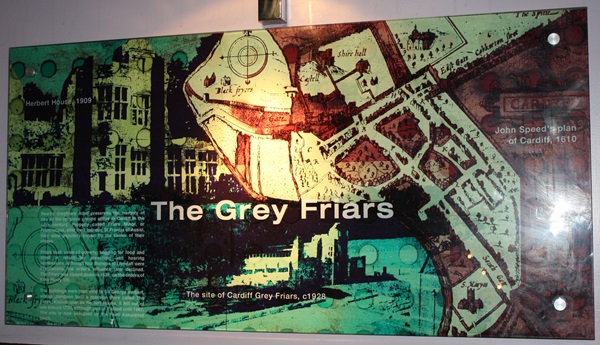
The text reads: Nearby Greyfriars Road preserves the memory of one of the religious groups active in Cardiff in the 13th century. Properly called Friars Minor, or Franciscans, after their founder, St Francis of Assisi, they were popularly known by the colour of their cloaks.
Friars took down vows of poverty, begging for food and drink in return for preaching and hearing confessions. Although four Bishops of llandaff were Franciscans, the order’s influence later declined. The Friary was closed down in 1538, on the orders of King Henry VIII.
The buildings were then sold to Sir George Herbert, whose grandson built a mansion there called the Friars. Known later as Herbert House, it fell out of use around 1730, although part of it stood until 1967. The site is now occupied by the Pearl Assurance.
Illustrations include: Herbert House, 1909;
The site of Cardiff Grey Friars, c1928;
John Speed’s plan of Cardiff, 1610.
Illustrations and text about the history of Cardiff Castle.
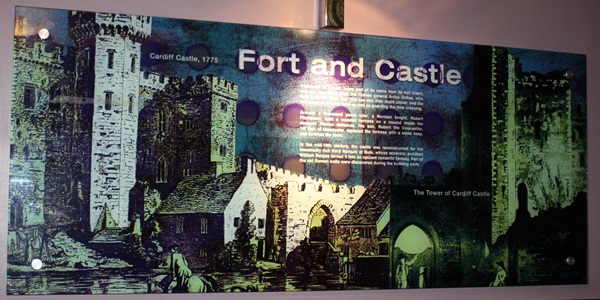
The text reads: Caerdydd or Cardiff, takes part of its name from its fort (caer), and the rest either from the Roman general Aulus Didicus, who built it, or the river Taff. The sea was then much closer, and the fort acted as a navel base as well as guarding the river crossing.
Around a thousand years later, a Norman knight, Robert Fitzhamon, built a wooden fortress on a mound inside the decayed Roman defences. His son, Robert the Counsellor, 1st earl of Gloucester, replaced the fortress with a stone keep, and fortified the town.
In the mid-19th century, the castle was reconstructed for the immensely rich third Marquis of Bute, whose eccentric architect William Burges turned it into an opulent romantic fantasy. Part of the old Roman walls were discovered during the building work.
Illustrations of Cardiff Castle and William Burges, plus a photograph of John, Third Marquess of Bute.
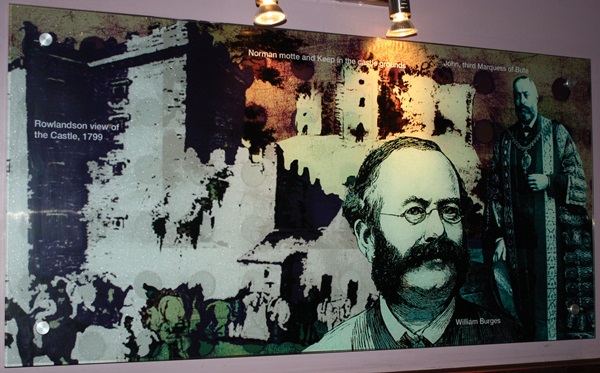
The illustration includes: Rowlandson view of the Castle, 1799;
Norman motte and Keep in the castle grounds;
William Burges;
John, third Marquess of Bute.
Prints and text about The old Empire Theatre and New Theatre.
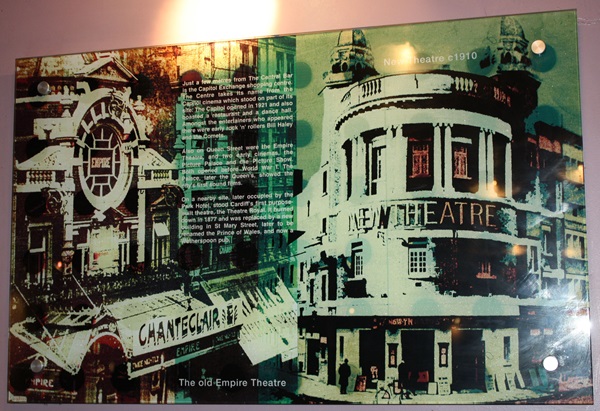
The text reads: Just a few metres from The Central Bar is the Capitol Exchange shopping centre. The centre takes its name from the Capitol cinema which stood on part of its site. The Capitol opened in 1921 and also boasted a restaurant and a dance hall. Amongst the entertainers who appeared there were early rock ‘n’ rollers Bill Haley and the Comets.
Also on Queen Street were the Empire Theatre, and two early cinemas, the Picture palace and the Picture Show. Both opened before World War I. The Palace, later the Queen’s, showed the city’s first sound films.
On a nearby site, later occupied by the Park Hotel, stood Cardiff’s first purpose-built theatre, the Theatre Royal. It burned down in 1877 and was replaced by a new building in St Mary Street, later to be renamed the Prince of Wales, and now a Wetherspoon pub.
Prints of the Empire Theatre and The Capitol.
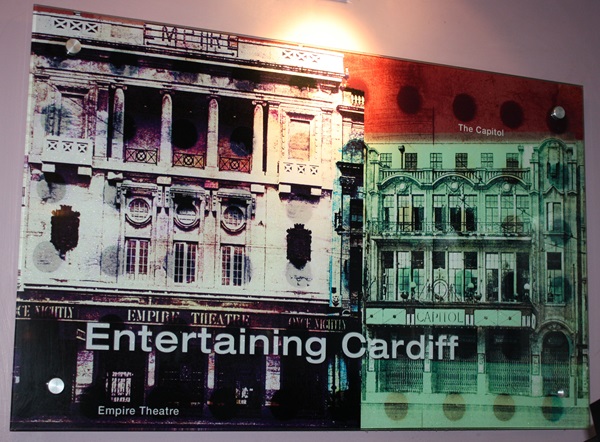
The City United Reformed Church, formerly The English Presbyterian Church, located a few metres away from The Central Bar, on Windsor Place.
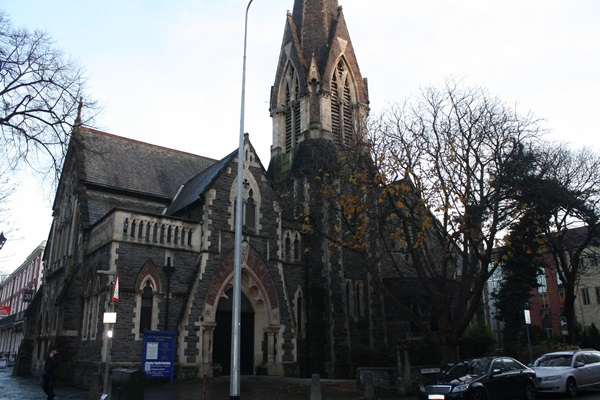
A piece of modern art by Phil Edmonds,some of whose work is displayed in the pub.
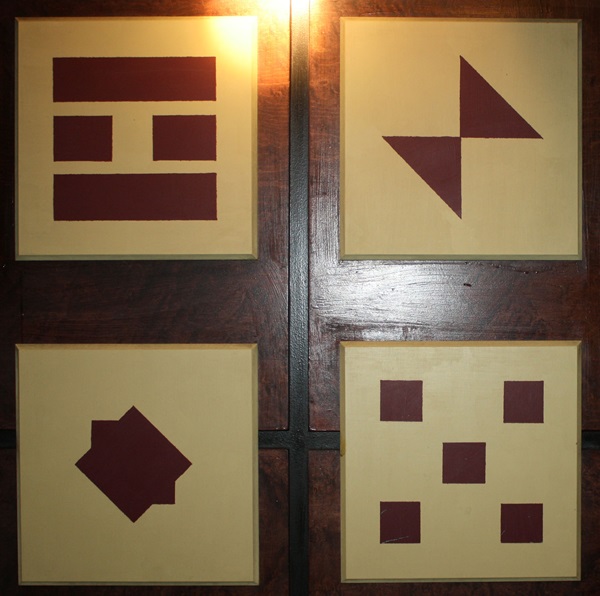
External photograph of the building – main entrance.
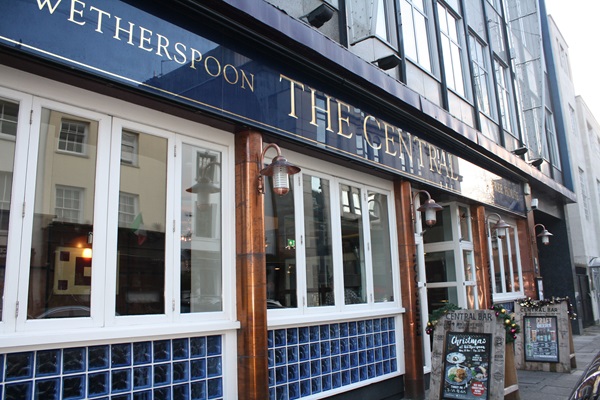
If you have information on the history of this pub, then we’d like you to share it with us. Please e-mail all information to: pubhistories@jdwetherspoon.co.uk